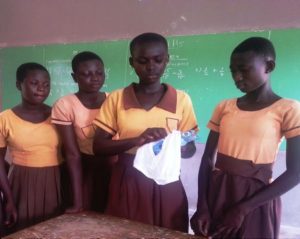Girls and their “Red Days”
The health of women of all ages is an essential need for sustainable urban development. Research among adolescent girls has shown the importance of education and emotional support in girls’ understanding that the onset of menstruation is a healthy and hopeful part of growing up.
In Akan society, the transition of a girl into womanhood, marked by menarche, is an occasion that is celebrated and held in high esteem by the community. In the days of old, girls who had attained their menarche were ushered into womanhood by a celebration known as “Bragoro.”
Euphemisms such as “w’akum sono” – literally, “she has killed an elephant” – and others, such as “w’ako afikyire” (“she has gone to the backyard”) or “w’abu ne nsa” (“she has broken her hand”), are used to describe the monthly flow of blood, which is linked to fertility and the sanctity of new life.
In the traditional communities of yesteryear, the young girl who had just passed into womanhood would be given an additional piece of cloth to cover her breast down to her knees and would put a loin cloth in between her legs through her circle of gorgeous waist beads, both to catch her monthly flow of blood during her menses and to guard her womanhood from unwanted “visitors.”
In those days, the majority of the girls had their menarche in the latter part of the teens – usually between 16 and 18 years of age. Once the “Bragoro” was performed, the young woman was declared ready for marriage, and no girl worth her salt stayed unmarried more than a year after her “Bragoro.” Those were the days when the lot of a woman was to support her husband and bring forth children, to increase the labour force for their agricultural enterprise.
With improved nutrition, girls today start their menses quite early in life, and it is on record that girls as young as 9 have had their menses, with the average age of onset for the majority of girls being 13. With modernization and the hopeful change in society’s view of female education, early marriages and child brides are not as common as before, and girls are now marrying in their 20s. This positive trend nevertheless poses a major challenge for teenage girls of today, most of whom are in school and have no source of income, yet they need to acquire suitable sanitary pads to deal with their menses.
The days of the loincloth in between the waist beads ended with the invention of disposable sanitary towels. However, these towels come at a cost and not all girls are able to buy them every month. Thus for some school-going girls, absenteeism becomes the norm during the week of their menses. This absenteeism can lead to poor school performance and heighten many girls’ desire to be done with school as soon as possible.
In a bid to encourage girls to go to school and stay in school even during their menses, an organization known as Days for Girls International has introduced the reusable sanitary kit that makes it possible for a girl to purchase a one-time kit that will last over 36 menstrual cycles. By the kind courtesy of Mrs. Patti Law, a Presbyterian Minister from Stratford, Connecticut in the United States, thirty-six kits were donated to the Women’s Health to Wealth to undertake a pilot study with members of the WHW Girls Clubs.
WHW undertook focus group discussions with students of Junior High Schools in in 3 districts Afigya Kwabre, Atwima Kwanwoma, and Kwabre East districts to understand the current knowledge, attitude and practices of teenage girls in the peri-urban communities with regards to the sanitary materials used during their menstrual flow and to explore the acceptability of the reusable kits.
Participants
A total of 99 girls aged between 12 and 18 years participated in 7 focus group discussions. Ninety of the girls had started menstruation while 9 had not attained menarche. See Appendix 1 for more detail.
Objectives
The following outlines the objectives of the focus group discussions:
- To introduce the use of the Days for Girls International reusable sanitary kits.
- To get the views of girls on how they would feel about using the reusable sanitary kit.
- To identify girls who have difficulty purchasing regular sanitary pads as beneficiaries to pilot the free reusable kits.
Overview of Discussions
The discussions that were moderated by WHW team members centered on menstruation, the cost of materials used to staunch flow and how the girls would feel about using a reusable sanitary kit.
The girls were taken through the use of the Days for Girls International sanitary kit which includes a monthly menstrual record chart from WHW, 8 pieces of flannel (reusable pad), 2 shields that holds the flannel in place, a small bar of soap, an empty Ziploc bag and a face towel.
Observations and Findings
- A small number of girls were able to define menstruation and discuss the changes that characterises adolescence.
- A majority of the girls had heard about menstruation before they attained menarche. Over half of them heard about it from their female teachers, while of the remaining half, equal numbers had heard of menstruation from their mothers and from friends. A small minority gave their source of information on menses as female relatives, such as older sisters and grandmothers. Girls confirmed that their mothers hardly interact with them because they disrespect them sometimes.
- Most of the girls said their mothers/guardians warned them after attaining menarche that sexual intercourse with the opposite sex will result in pregnancy.
“My grandmother told me to desist from engaging in unnecessary acts of play with the opposite sex, if not, they will swallow me up!” – a 15-year old club member.
- About half of the participants use sanitary pads in staunching the blood flow during their menses. YAZZ, Proper, Beauty Lady, Soft care, Forever Easy, Yovi, Cute, Always and Sandy are some of the brands used. These pads cost between GHC 3.50-6. The rest of the girls use other toilet paper, baby diapers and pieces of old cloth when they are menstruating.
- About two-thirds of the girls reported that their parents/guardian provide money for their monthly purchase of sanitary pads, while the remainder have to save from their meager daily allowances of GHs1 towards this purchase.
- Girls were very happy when they finally saw the kit of reusable sanitary pads, which they agreed is very attractive.
“This is beautiful! It looks like a handkerchief, and I wouldn’t mind hanging it outside. No one would notice that I use it to manage my menses.” – a 14-year-old girl at Piase.
- Girls indicated their readiness and willingness to buy and use the reusable sanitary pads if the cost of the Days for Girls International sanitary kit is priced between GHC 5-15. Girls claim that the current price quote of GHs 35 will be prohibitive and will incur the wrath of their parents. As aptly said by one 14-year-old girl at Twedie,
“My father will say, quote, “I cannot even afford what I need to buy rat poison to kill myself and be free from the crippling poverty, how can I afford something this expensive!?”
- Apart from a few girls who claim they feel uncomfortable washing their blood-stained panties, the majority of the girls did not seem to have a problem with doing so.
“ I do not have a problem with washing my panties when they are stained with blood because it is from my own private part” – a 15-year-old girl from Esereso.
Based on the interactions with the girls, 25 girls in the four districts were each given a Days for Girls International Sanitary kit.
Next Steps
The 25 beneficiaries in the various districts are to give WHW feedback on the use of the sanitary kits in December 2015. This feedback will be extremely useful in determining whether to promote and get more kits for use by girls in school who have difficulty purchasing regular sanitary pads.
Conclusion
While WHW awaits the feedback from our beneficiaries, we would want to acknowledge with thanks for the gift of 30 kits from Ms. Patti Law, which set us on this path. We also will discuss the cost of the kit with the Days for Girls International office in Accra, as the asking price of GHs 35 is out of reach for the girls we are hoping to serve.


